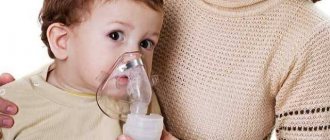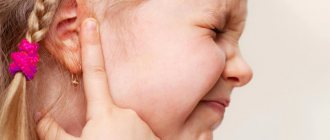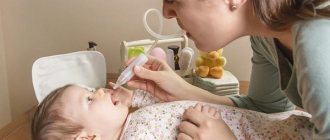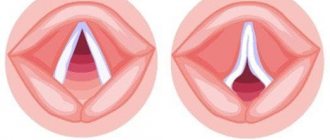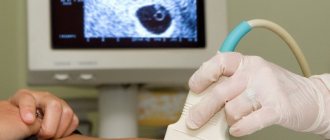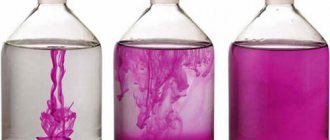Benefits of rinsing your nose with saline solution
Saline solution used to rinse a child's nose has beneficial effects:
- Moisturizes the nasal mucosa, which is important not only during illness, but also during the heating season, when apartments are hot and dry;
- Clears the nasal passages of dust particles, as well as dangerous microorganisms, viruses and bacteria;
- It thins mucous secretions, making them less thick and viscous, allowing them to flow down the throat. As a result, the child swallows them, which does not harm his health, but breathing is restored;
- Swelling of the mucous membrane decreases, inflammation becomes less severe. As a result, breathing through your nose becomes easier and freer.
Advice. In addition to taking care of the mucous membrane, you need to remember about humidifying the room. This brings the moment of recovery closer. Being in a room with dry, stale air has a bad effect on the well-being of not only children, but also adults.
Pharmaceutical preparations containing sodium chloride
The isotonic solution is sold in bottles or sealed bags. Such containers are completely sterile and sealed with an airtight stopper. The drug is taken into a syringe by puncturing the rubber stopper. Pharmacy options for nasal rinsing are much more convenient. They are available in drop or aerosol format. They have a special sprayer that converts saline solution into an aerosol. The safest and most universal are those products based on sea water.
Nasal rinsing preparations for children:
| Spray, drops | Sterile hypertonic solution with natural sea salts. 100 ml of the drug contains 30 ml of Adriatic Sea water and 70 ml of purified isotonic water. The product is colorless, transparent, odorless | ||
| Sodium, chlorine and calcium ions | Spray and drops for nose, mouth and throat | A drug for thinning mucus. Moisturizes the nasal mucosa and relieves inflammation. It has a safe concentration of mineral salts of 8-11 g/l. Does not dry out the nasal mucosa even with frequent use |
|
| Spray | Salin is a drug used in otolaryngology for inflammatory and bacterial diseases of the respiratory system. Quickly clears mucus from the nose and restores the sense of smell |
|
| Solution | Doflin is available in the form of a soluble powder. The kit includes a jar into which the drug is poured. Warm boiled water is used for dilution. The jar has a special pipette, which is convenient for instilling the product. Used for chronic diseases of the nasal canals. Contraindicated in children under 4 years of age |
| Quicks | Atlantic Ocean water. Contains 2.6% salt per 100 ml | Solution, aerosol | The drug can be used for a long time; the mucous membranes do not get used to it. Has a mucolytic effect. Strengthens the property of tissue effusion, which leads to hydration and discharge of snot |
All pharmaceutical solutions for rinsing the nasal passages are used heated. They are heated in the hand for 30 minutes. The use of sea water-based products moisturizes the mucous membrane, washes out microbes and reduces inflammation. Preparations in spray format are highly effective, but are not used for children under 2 years of age .
Sodium chloride for rinsing the nose, also known as saline solution
What does saline solution look like? Saline solution is an absolutely transparent, sterile isotonic solution of ordinary salt or sodium chloride with a concentration of 0.9%. It is available in the form of bottles, sealed with rubber and aluminum caps, with a volume of:
- 100 ml;
- 200 ml;
- 400 ml.
You can also purchase ampoules with this medication, volume:
- 5 ml;
- 10 ml;
- 20 ml.
In medicine it is widely used for:
- dilutions of all kinds of drugs produced in the form of powder for injection;
- removing toxins from the blood in case of all kinds of poisoning;
- replenishing fluid deficiency due to dehydration, etc.
It is widely used for washing the eyes, mouth, vagina and, of course, nose, and, therefore, any doubts whether irrigation can be done with saline solution for droppers are not justified.
In addition, it is an analogue of all modern saline solutions, packaged by caring manufacturers in easy-to-use dropper bottles and aerosol cans. There are a lot of such drugs. A pharmacist at any pharmacy will be able to name at least 10 of them. This:
- Marimer;
- Physiometer;
- Aquamaris;
- Humer;
- No-salt;
- Quicks et al.
They differ only in appearance and how much regular saline solution costs, because its price is several times lower than that of ready-made medicines. Therefore, if you don’t want to overpay, and you have the opportunity to spend a few minutes more on the washing procedure, you should confidently choose it.
What is saline solution and what does it help with?
Saline solution is a medicine containing distilled water and NaCl salt (0.9%). The product is not dangerous for the child’s body; pediatricians approve of its use.
Washing with saline solution helps:
- moisturize the nasal mucosa;
- destroy pathogens that cause colds, rhinitis and acute respiratory infections;
- make mucus more liquid and remove it from the nasal passages;
- create optimal microflora in the nasal cavity;
- relieve inflammation;
- wash away allergens - especially useful if the child has inhaled dust.
The drug is used to treat runny nose, sinusitis, otitis (as an auxiliary medicine), acute respiratory infections. Rinsing is also recommended for allergies, as it allows you to wash out the allergen from the nasal passages. In addition, pediatricians advise carrying out the procedure to moisturize the mucous membrane and prevent seasonal diseases.
How to prepare saline solution for rinsing the nose at home
The cost of the drug in a 200 ml bottle is 20–40 rubles. And although the price at the pharmacy allows anyone to purchase it, you can prepare a saline solution that is in no way inferior in quality at home with your own hands from the products available in the kitchen.
The recipe is simple and preparation takes a couple of minutes. Necessary:
- Boil 1 liter of water.
- Dilute 2 tsp in it. regular table or sea salt without flavorings, dyes and other chemicals. For children, the amount of salt should be reduced to 1 tsp.
- Be sure to strain the finished product through a fine sieve, or better yet, gauze folded in several layers, in order to remove all undissolved particles and pebbles that are often found in salt.
- The saline solution is ready for use as soon as its temperature reaches 25–30 °C.
Attention
If a burning or pinching sensation occurs during the procedure, this is a sign that the solution concentration is too high.
In such situations, you should immediately dilute it with additional warm boiled water.
If we talk about whether it is necessary to dilute a saline solution purchased at a pharmacy, then this is only required in similar cases, that is, when tingling occurs, which is extremely rare.
When treating sinusitis, you can make your own mixture with Dioxidin. The drug has antibacterial properties and speeds up the healing process. You can also add additional antibacterial and anti-inflammatory properties to ordinary saline solution by adding to it:
- 1 tsp. soda;
- 1 drop of iodine.
These proportions are indicated for 1 liter of liquid.
How often can you rinse your nose with saline solution?
Many people wonder whether it is harmful to rinse your nose every day. If irrigation is preventive, then it is harmful.
If you have a severe runny nose, you can wash it daily up to 5 times a day, an hour after meals, until the congestion disappears. After this, it is permissible to rinse your nose for hygienic purposes 1-2 times a week in the morning or before bed.
Before you start rinsing your children's nose, you need to contact your pediatrician. He will tell you how often you can rinse infants and older children with saline. Usually, if indicated, irrigation is carried out up to 5 times a day.
How to rinse your nose correctly
Various devices are used for irrigation:
- Neti pot (resembles a teapot with a long narrow spout);
- syringe;
- rubber bulb;
- nebulizer (bottle for inhalation);
- syringe.
You can choose anything, depending on your own convenience. When using means that create pressure (syringe, bulb), it is important to ensure that it is not very strong. To carry out cleansing procedures, you will need 150-250 ml of solution for each nostril.
Before rinsing, you must make sure that your nose is breathing at least a little, otherwise the procedure will be useless. To increase patency, 10-15 minutes before irrigation you need to instill a vasoconstrictor and then blow your nose well. Depending on the disease, you can wash it in different ways.
With the withdrawal of saline solution through the second nostril
Suitable for:
- allergic rhinitis;
- rhinitis;
- inflammation of the sinuses.
Why do children need to rinse their noses?
It seems that nature has thought of everything, and there is no need to interfere with natural processes. In fact, a baby is not able to reject contaminants in the nose, as an adult does. No matter how clean the house is, dust, lint from textiles, etc. still gets into the nostrils. Also, natural mucus accumulates inside, which dries out, forming crusts. If you systematically rinse your baby’s nose, this will make him feel better, and you will immediately see changes in his mood. The baby breathes easier, eats and sleeps better. If he still cries, then you should look for the cause of concern elsewhere.
Some babies' nasal passages are too dry and may not produce enough fluid to moisturize them. It hurts the child to inhale air, so he begins to be capricious. Nasal rinsing can solve this problem. Soon the nasal cavity will be able to secrete the necessary amount of fluid to maintain normal conditions. For now, this task is entrusted to mom and dad.
A nose that is clear of mucus and crusts not only allows the baby to breathe easier. It is not contaminated, which means it does not allow infection to accumulate or penetrate into the body. Regular nasal rinsing reduces the incidence of infectious diseases. The nasal cavity is moistened, so minor bleeding is less likely to occur.
This hygiene procedure is especially important for children who are sick. Rinsing will prevent infections in the nasal cavity from multiplying and leading to complications, such as sinusitis or otitis media.
Is it possible to rinse a baby's nose with saline?
Washing is not contraindicated for an infant. On the contrary, they help get rid of many ailments.
Babies under 3 months have a physiological runny nose, which is considered normal. There is no need to treat it, but it is possible to clear the airways of mucus. Saline solution will help with this.
In addition, the product will help:
- moisturize the mucous membrane, accordingly, the risk of acute respiratory infections and diseases of the ENT organs will decrease;
- remove allergens - particles of dust, lint or pollen;
- prepare the baby’s body for treatment with other medications;
- relieve swelling, cure runny nose.
How to rinse a baby's nose with saline solution
Many caring parents ask pediatricians whether it is possible to drip saline into the baby’s nose, how often and how much.
The product is not contraindicated for either a growing baby or a newborn, but, most importantly, the procedure is carried out correctly.
For children under one year of age, any medications are administered exclusively in the form of drops. Therefore, you need to do the rinsing with a pipette or buy plastic ampoules with a small volume of saline solution.
It is usually recommended for an infant to instill 3-4 drops of saline solution for therapeutic purposes into each nasal passage. There can be up to 5 such sessions per day.
When cleaning children's noses, special attention should be paid to how to dilute saline solution at home. For infants, it is better to even slightly reduce the standard proportions and take only ½ tsp. salt per 1 liter of water.
Nasal rinsing technique
Step-by-step instructions on how to rinse a baby’s nose with saline:
- Prepare the child by placing him on his back;
- Wipe your nose with a damp swab, removing visible dirt and crusts located on the surface;
- Turn the baby's head so that the nostril that you plan to rinse first is at the top;
- Pour in 3-4 drops of solution, 1-2 is enough for a newborn. The pipette does not need to be inserted inside - if the baby twitches, he can be injured. To make it more comfortable, the baby’s head is tilted back a little;
- Turn the baby over and repeat the procedure from the second nostril;
- After a few minutes, the crusts will soften, the mucous membrane will moisturize, then you can remove the secretions with an aspirator. It is convenient to use a mechanical nozzle pump, the force of which is regulated by parents. One end of the device is inserted into the child’s nostril, the other is in the mother or father’s mouth. They inhale air, and the snot is sucked into a special container. A filter prevents them from getting into the tube and the mouth of adults, which must be cleaned after the procedure and changed periodically.
Removing snot with an aspirator
Note! If a child is seen by a doctor and is prescribed medicinal drops, they should be used after cleansing the nose. Even vasoconstrictors are used after washing. They cannot be dripped often; they are allowed to be used only in extreme cases, if the child cannot breathe, which is why he cannot eat and sleep normally.
How to prepare the solution?
For the washing procedure, a so-called saline solution is used. It is called so because its osmotic pressure corresponds to that in the cells. This means that when it enters the body, there is no loss or excessive accumulation of water by its tissues. Deviation of osmotic pressure leads to metabolic disorders between cells and blood, as well as fluid loss.
Today, pharmacy chains offer many types of ready-made nasal rinses. Their cost varies and depends on the volume, form of release (drops, sprays), and manufacturer. Salin, Aquamaris, Humer, Marimer - these drugs contain the same isotonic sodium chloride solution.
What is the difference between a saline solution prepared for a baby at home and a pharmaceutical solution? The requirements for liquid medicinal products are such that they undergo extensive purification during the production process. Therefore, the contents of the bottle you purchase will be absolutely sterile, and using factory packaging is undoubtedly more convenient.
Pharmaceutical products necessarily contain substances that increase shelf life, to which there may also be individual sensitivity. At the same time, using a factory bottle will be more convenient. Whether you buy saline solution or prepare it yourself is up to you.
The advantage of the product can be considered the almost complete absence of contraindications and a low likelihood of developing allergies.
The saline solution contains sodium chloride, known as common table salt. According to the instructions for medications, the nasal rinsing solution contains 6.5 g of sodium chloride per 100 ml of prepared water. Thus, we need:
- Take 6.5 g (flat teaspoon) of table salt and dissolve in a liter of filtered water. You can also measure this amount with a pharmaceutical beaker, a special spoon, or suitable scales.
- Boil.
- Strain through several layers of sterile gauze.
- Boil again.
It is impossible to store a freshly prepared solution for more than a day, since after this time there is a risk of proliferation of unwanted microorganisms in it.
Sometimes it is recommended to add iodine to the prepared solution to bring the composition closer to sea water. Do not do this. This will not affect the healing properties of the saline solution. Children are especially sensitive to allergens, and iodine is a strong provocateur that can cause severe manifestations, including laryngeal stenosis and anaphylactic shock.
Is it possible to breathe saline solution through a nebulizer?
When treating the respiratory system, inhalations are very popular. The main means for carrying them out is saline solution. Inhalation device – nebulizer. It is with the help of a nebulizer that a person can achieve a lasting effect, since it sprays the medicine along the nasal mucosa (converts sodium chloride into an aerosol). The device allows you to quickly deliver the medicine to the bronchi, having a beneficial effect on them.
To use the device, you need to pour saline solution into a special compartment. To achieve the best effect, mix the liquid with Chlorophyllipt for inhalation in a nebulizer. Then, using a mask or mouthpiece, breathe through your nose and mouth. At the end of irrigation, it is advised not to talk for about half an hour, and also not to go outside or consume food or liquid. You can do inhalations 2-3 times a day.
The purpose of using saline solution during inhalation with a nebulizer is to liquefy mucus and remove it. The main thing is to dilute the drug correctly.
Instructions for use of saline solution
saline solution is introduced into the nasal passages in the form of instillation, rinsing or inhalation using a nebulizer. All three methods are effective and make it possible to use saline solution for any age category of a child.
Instillation of saline solution for children
How to drip saline into a child's nose?
Instillation of saline solution into a child’s nose can be done from the moment of birth.
- Using a pipette, three drops of 0.9 percent sodium chloride are dripped into each nostril at intervals of four hours.
- The number of drops can be increased if necessary.
Rinse the nose with saline solution
Rinsing a child's nose consists of several stages. Don't be afraid of this manipulation. A mother should be able to provide assistance to her child and learn how to properly rinse the nasal passages with saline.
- It is necessary to prepare equipment. Decide what will be used for washing, it can be: a syringe, a pipette, a syringe or a small pear-shaped bottle
Devices for washing with saline solution - Then the baby's airways are cleared using a pear-shaped balloon, or the modern Otrivin Baby, in which one end of the tube is inserted into the child's nose, and with the help of the second, the mother sucks out the contents of the nasal passages and mucous secretions are collected in a specially designated compartment.
Using an aspirator to cleanse the nose - When using a syringe, you must remove the needle and draw five milliliters of saline into it.
An excellent solution is a syringe with a soft tip. The child is placed on his side and two and a half milliliters of 0.9 percent sodium chloride are injected into the nostril located above. Then the baby’s mother turns it over to the other side and continues the procedure only with the other nostril. Soft tip syringe - After the solution is injected into the nostril, it is removed along with the remaining mucus using a pear-shaped can.
Two turundas should be prepared from cotton wool, with which the nasal passages are drained and cleansed from the inside. Preparation of turundas for the nose - When carrying out manipulation for the purpose of prevention, at this stage it ends. If a child is sick, after rinsing with saline, he needs to drip a medicine into his nose, selected individually, based on the child’s age. In our article you will find effective medicines after washing for children from one year old.
During the procedure, the baby may choke from excess fluid. If this happens, you need to lay him on his tummy and lightly tap him in the area of his shoulder blades. When performing the manipulation, the stream supplied to the nose should be under low pressure.
At the same time, it is strictly forbidden to tilt the child’s head back so that the solution does not enter the Eustachian tube and provoke a complication in the form of otitis media.
Inhalations with saline solution in a nebulizer
Carrying out inhalation of saline solution to a child
Inhalation procedures using a nebulizer help cope with rhinitis and are carried out for preventive purposes.
- For manipulation, it is necessary to use a factory-made, sterile solution of 0.9 percent sodium chloride.
- The amount of liquid is calculated based on the age of the child. Four milliliters is enough for the baby. For school-age children, the dosage is increased.
- The manipulation is carried out for five minutes up to three times a day. During inhalation, the child should gently inhale the vapor. After the procedure, it is not recommended to feed or go into the fresh air with the baby for one hour.
You should not use 0.9 percent sodium chloride in the form of steam inhalations; it contains salt, which settles at the bottom and is not able to volatilize. There will be no positive effect from the manipulation, because the components of the drug will not get into the nasal passages with the vapor.
Is it possible to rinse your throat?
For throat diseases, the solution is also used. Moreover, it is used in pharmaceutical concentration. There is no need to dilute it with water. You need to gargle at least twice a day. In a situation where the disease occurs with complications, it is necessary to treat the throat at least five times a day. In this case, you need to combine it with the use of other antiseptic solutions. It is recommended to irrigate not only the throat, but also the nose. For inflamed tonsils, it is recommended not to rinse, but to organize absolute rinsing (the liquid passes through the nose into the mouth).
A tool with a wide range of functions
Let's understand what saline solution (saline solution) is. The medical term is 0.9% sodium chloride solution. To prepare an isotonic solution, several types of salts are used at once. After they are completely dissolved, the last ingredient is added - glucose. To prepare saline solution, use only glass containers and distilled water.
Sodium chloride is a multifunctional drug. Its composition is table salt, which has excellent antibacterial properties and promotes rapid wound healing, for which it is most often used in medicine.
But it was found that if you properly rinse your nose with saline when you have a runny nose, the pathogenic bacteria are destroyed. Therefore, with the help of sodium chloride, you can not only treat wounds, but also carry out treatment to prevent a runny nose. Not only doctors, but also scientists agree with this conclusion. It is enough to note that one of the authoritative doctors for many mothers, Dr. Komarovsky, is of the same opinion.
Saline solution has a wide spectrum of action. It is used:
- for diluting medicines;
- for antibacterial cleansing of wounds, burns, bedsores and other things;
- for moisturizing dressings, which are used for lotions on purulent wounds, abscesses, boils;
- for washing the eyes for inflammatory diseases of the cornea;
- for rinsing the nose with a runny nose;
- for inhalation using a nebulizer;
- intravenously for dehydration, vomiting, diarrhea.
Efficacy for sinusitis
For a disease such as purulent sinusitis, saline solution is recommended as a medicine for washing pus from the sinuses and nasal appendages. Thanks to the procedure, you can prevent and stop the spread of germs. Irrigation should be carried out every hour. It is also recommended to alternate means when washing (for the first time - saline solution, then - with a liquid that contains herbal preparations).
For sinusitis, rinsing the nose with saline is an additional measure. It is not an independent operation; it is used in combination.
Indications for the rinsing procedure
Some doctors recommend rinsing your child's nose daily. But such an approach to hygiene does more harm than good. The baby’s nose contains neutral microflora, which does not cause harm if the immune system is healthy. If you constantly wash it off, local immunity will weaken, and the child will remain defenseless against the environment.
Too frequent rinsing of the nose leads to excessive moisture in the mucous membrane. The nasal cavity receives moisture from external sources, so the independent production of secretions is reduced. After stopping the course of rinsing procedures, the child’s nasal mucosa will begin to dry out and crack greatly. Bacterial microflora enters these wounds, where they begin to develop. A crust of mucus forms, which prevents the child from breathing. The nose will have to be rinsed again, thus creating a closed cycle.
Diseases for which saline solution is used to rinse the nose :
- Rhinitis. An infectious or allergic disease. Less commonly, rhinitis can occur as a reaction to irritation of the mucous membrane by dust. Before rinsing the nose, mucus should be removed from the nasal cavity.
- Sinusitis. Inflammation of the sinuses. The disease is most often chronic in nature, since bacteria penetrate into the cavities of the bone tissue and remain there for a long period.
- Sinusitis . Inflammation of the nasal mucosa. Occurs as a complication during infectious diseases with acute runny nose.
The physiological structure of the nasopharynx of a six-month-old baby is designed in such a way that even a small amount of mucus can make breathing difficult.
Precautionary measures
Despite the safety of the medicine, in practice there are a number of situations in which saline solution is used with caution:
- at risk of nosebleeds;
- the presence of polyps and tumors in the nasal passages;
- with a deviated nasal septum;
- swelling of the mucous membrane.
It is also necessary to be careful when rinsing small children with the product. It is recommended to carry out the procedure no later than two hours before going to bed at night or before leaving the house. It is recommended to use nasal drops 20 minutes after irrigation. Therefore, it is necessary to think through the treatment regimen in advance in order to prevent possible complications from occurring.
Contraindications
Experts identify a number of diseases in the presence of which it is not recommended to use saline solution for a runny nose.
Such pathologies include:
- otitis – inflammatory processes in the ear cavity;
- purulent forms of runny nose;
- a history of frequent nosebleeds;
- pathologies of the cardiovascular system;
- defects in water-salt metabolism in the patient’s body;
- presence of elevated temperature and fever.
The limitation in the use of the product is due to the fact that it affects the condition of the blood vessels and the intensity of the water-salt solution.
If there are pathologies in this area, it is worth using other remedies for the common cold that do not affect the tone of the vascular wall.
